Examples of Total Rewards Philosophy Explained
Understand total rewards philosophy examples with insights on market-competitive compensation, equity in pay, and wellness programs. Enhance retention. Explore now!
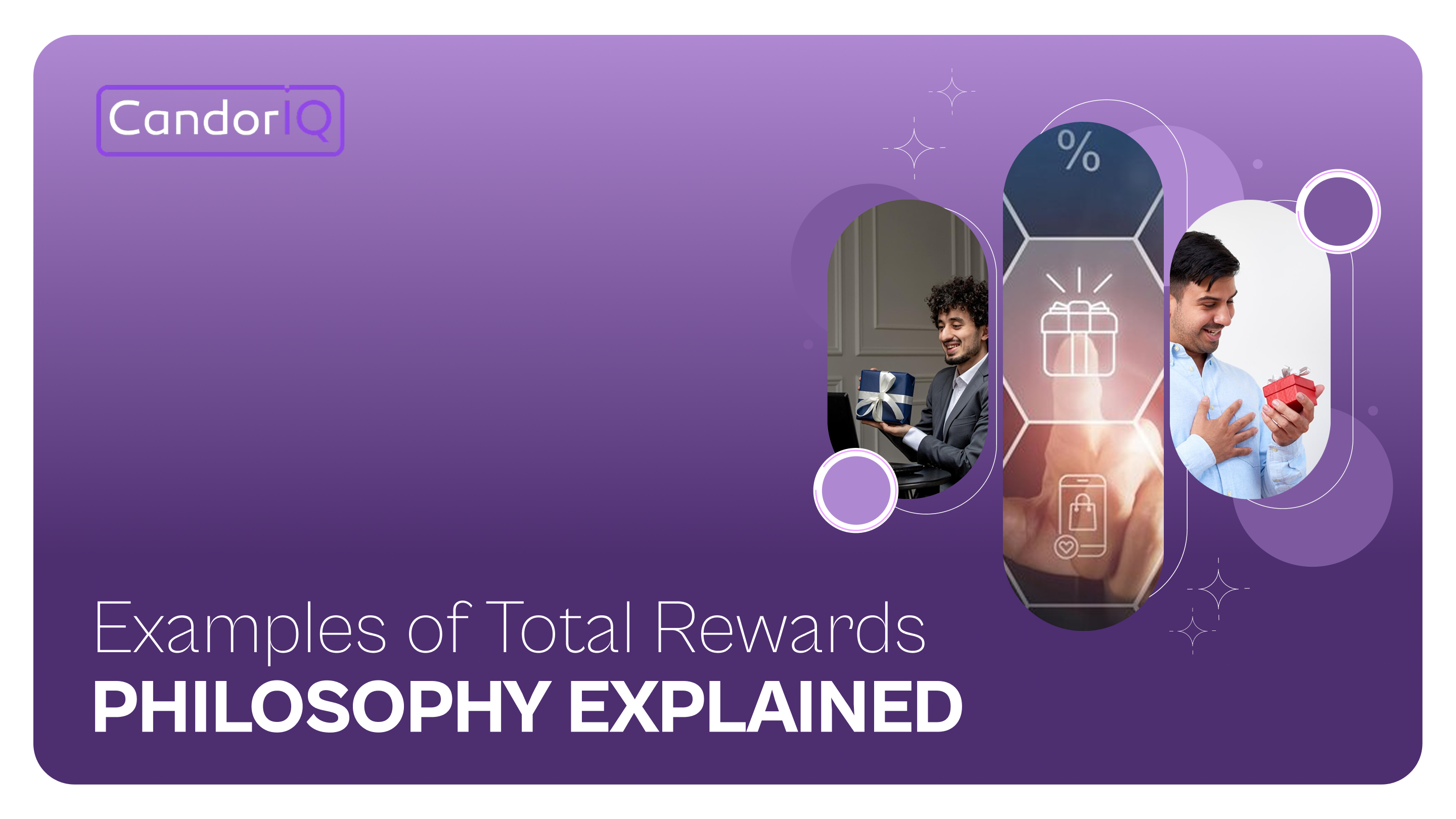
Rapidly growing companies face a tough balancing act: offering competitive pay while managing growth. In 2023, 67% of mid-sized businesses were struggling to align pay strategies with budget limits, especially in lean, global teams.
Without a clear total rewards philosophy, fragmented pay, benefits, and recognition programs can hurt engagement and lead to higher turnover.
This blog breaks down total rewards with real-world examples, helping CPOs, CFOs, and People Ops leaders see how unified reward strategies can boost retention, improve transparency, and make planning more accurate. Keep reading to learn how integrating compensation with the overall employee experience can make a difference as your company scales.
At a glance:
- Total rewards go beyond salary, covering compensation, benefits, career growth, work environment, and recognition, all key to employee retention.
- Five pillars for success: Fair pay, strong benefits, clear growth paths, positive culture, and meaningful recognition.
- Turnover is costly; replacing an employee costs 50-200% of their salary. A strong total rewards strategy reduces turnover and boosts retention.
- Top talent seeks more than salary; they value flexibility, growth opportunities, culture, and work-life balance.
- Build strategically: Audit your current state, segment employees, design each pillar, communicate clearly, and measure results.
- Alignment matters: Your total rewards program should support business goals, turning it into a strategic advantage.
- Implementation challenge: The real struggle is designing a program that reflects your goals and meets employee expectations.
What is Total Rewards Philosophy?
A total rewards philosophy is an organization’s overall strategy and guiding principles for how employees are rewarded, not just with pay, but with benefits, work environment, career growth, and recognition. It goes beyond money to offer a mix that aligns with both employee expectations and business goals.
A total rewards philosophy helps organizations leave behind transactional pay and build a people-first culture that attracts and retains top talent in any market. Now let's break down the specific elements that make it work.
Related read: If you're curious about how AI and technology are reshaping total rewards strategies, check out The AI-Powered Evolution of Total Rewards to see how companies are modernizing this approach.
Five Pillars of Total Rewards Philosophy
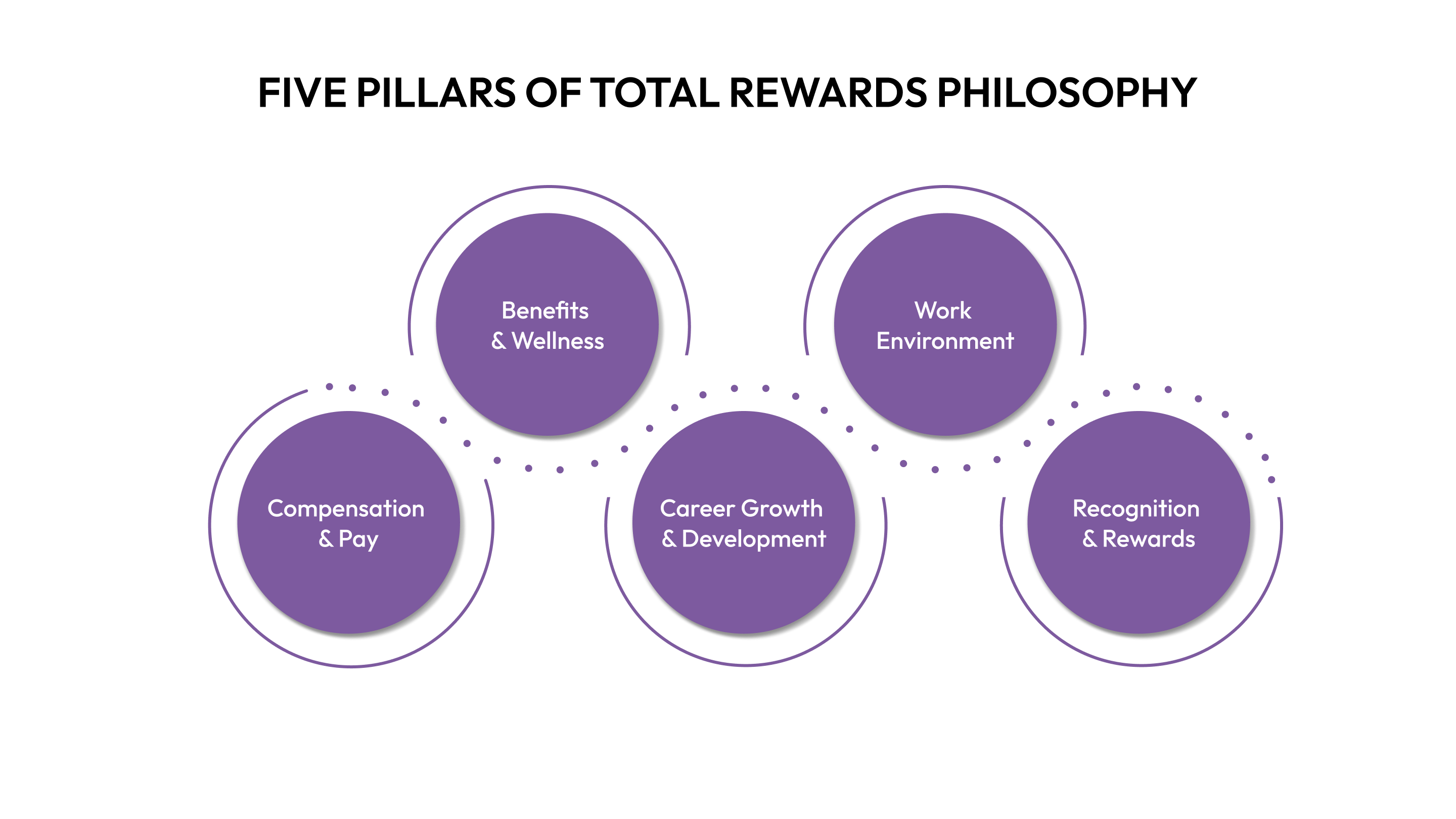
Total rewards philosophy has five distinct pillars. Each pillar plays a distinct role in creating a compelling employee experience. These are:
1. Compensation & Pay
This is the foundation. It includes base salary, performance bonuses, commission structures, and short-term incentives. Fair and competitive compensation signals that you value your employees' contributions.
When compensation is transparent and aligned with market rates, employees feel respected and recognized for their work.
2. Benefits & Wellness
Health insurance, retirement plans, and wellness programs protect employees' present and future. These aren't perks—they're essentials that directly impact employee security and peace of mind.
Modern benefits packages often include:
- Medical, dental, and vision coverage
- 401(k) or pension plans with employer matching
- Mental health and wellness programs
- Paid time off and parental leave
3. Career Growth & Development
Employees crave progression. Training programs, mentorship, promotion pathways, and skill development opportunities keep talent engaged and invested in your company's future.
Without clear growth opportunities, even well-compensated employees start looking elsewhere.
4. Work Environment & Culture
The day-to-day experience matters deeply. Flexible work arrangements, remote options, collaborative spaces, and a positive company culture shape how employees feel about coming to work.
A supportive environment where people feel valued and heard often outweighs a slightly higher salary at a toxic company.
5. Recognition & Rewards
Beyond the regular paycheck, meaningful recognition, whether through awards, bonuses, public acknowledgment, or special incentives, reinforces desired behaviors and shows appreciation.
Recognition doesn't always need to be monetary. Sometimes, a sincere acknowledgment of hard work is what employees need most.
These five pillars work together. Leave one out, and your total rewards package feels incomplete. But why do you need a total reward philosophy in your organization?
Explore further: Learn how strategic total rewards directly enhance employee experience at scale, from recognition systems to personalized benefit choices.
.png)
Why You Need a Total Rewards Philosophy?
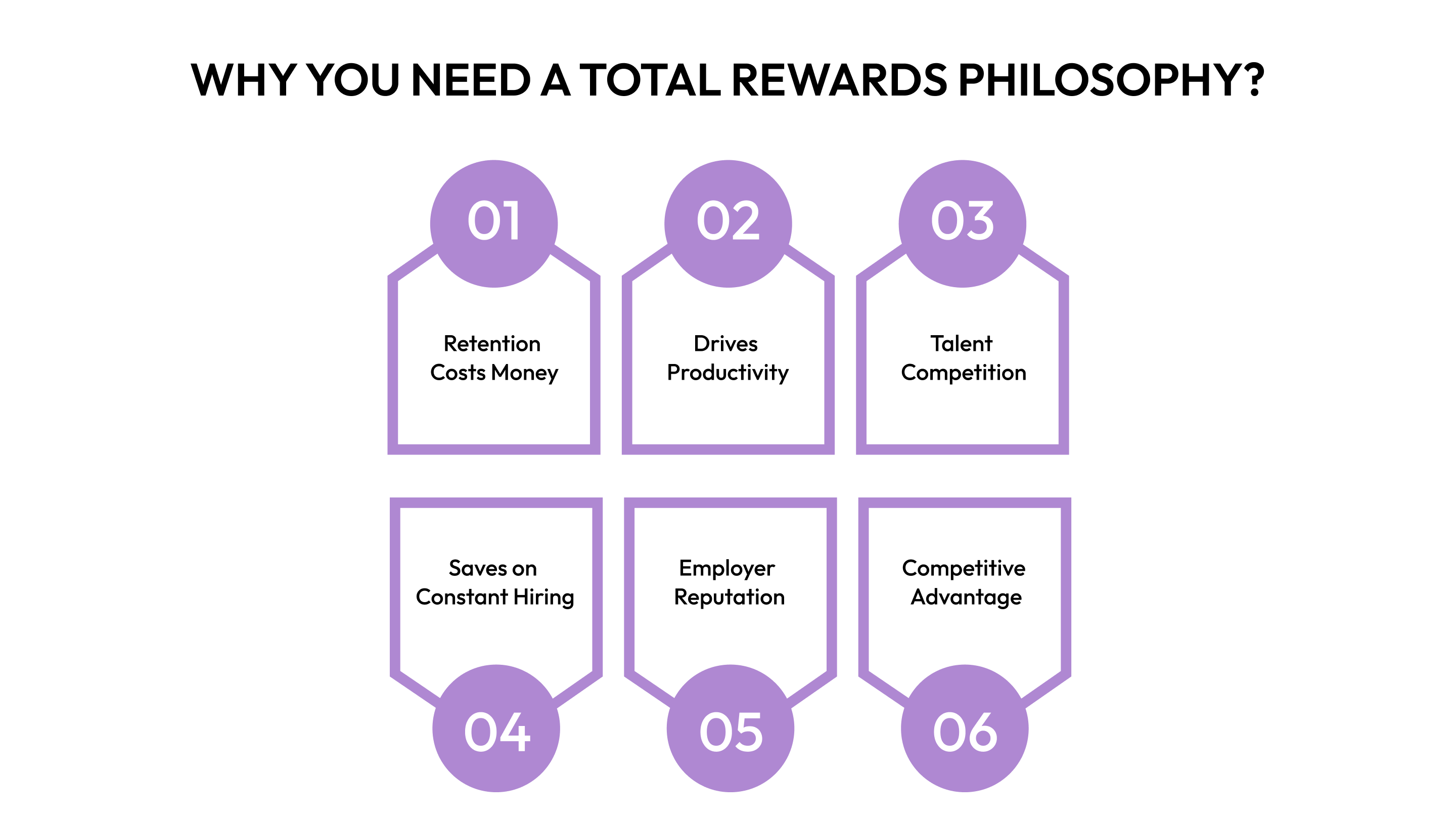
You might be wondering: "Is overhauling our rewards strategy really worth it?" The answer is yes. Here's why.
Retention Costs Money, Prevention Is Smarter
Replacing an employee typically costs 50-200% of their annual salary. Recruiting, hiring, onboarding, and training drain both time and resources. A solid total rewards strategy cuts turnover dramatically. When employees feel valued across all dimensions, they stay. When they only get a paycheck, they leave.
Engagement Drives Productivity
Employees who feel genuinely invested in their workplace are more productive. They take fewer sick days, produce better work, and contribute beyond their job descriptions. Total rewards create that investment. It transforms employees from doing a job into owning their role.
Talent Competition Is Fierce
The best talent has options. Top performers won't choose your company based on salary alone anymore. They evaluate the entire package: growth opportunities, flexibility, culture, and work-life balance. Companies with comprehensive total rewards strategies win the talent pool.
Retention Saves on Constant Hiring
Your institutional knowledge stays intact. Teams maintain momentum. Clients build relationships with familiar faces. These intangibles are impossible to price but massively valuable.
Employer Reputation Matters
Companies known for strong total rewards attract better candidates from day one. Word spreads fast in your industry. Great employees refer their friends. Your hiring becomes easier and cheaper.
Culture Becomes a Competitive Advantage
When compensation, benefits, growth, and recognition all align, you build a workplace people talk about, in a good way. This attracts mission-driven talent who want to be part of something meaningful.
However, understanding the philosophy is one thing. Actually implementing it is another.
Strategic insight: Discover how to strengthen your employee value proposition through total rewards. This is what differentiates companies that attract and retain talent from those that constantly compete for it.
How to Build Your Total Reward Program Step-by-Step
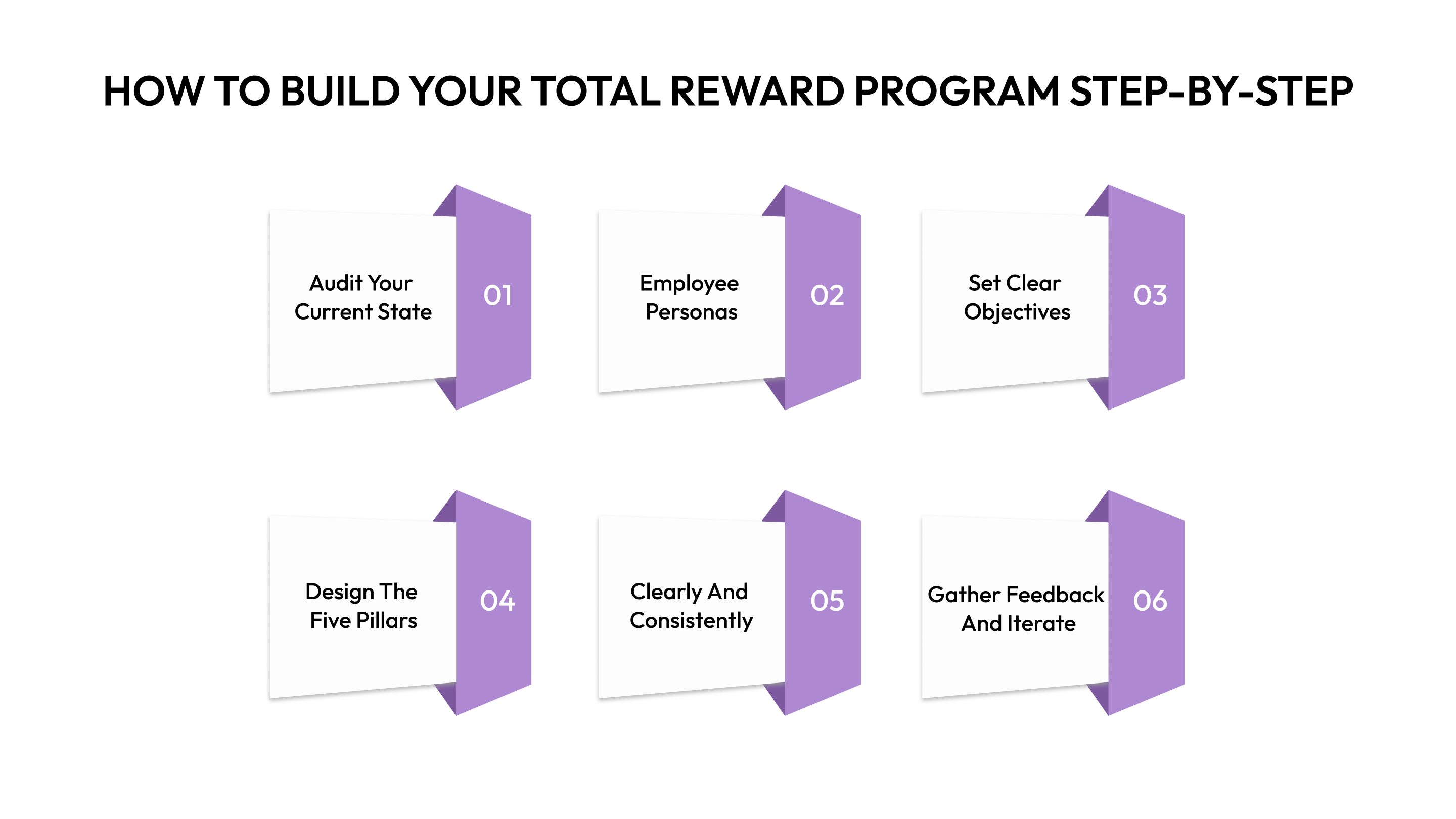
The companies winning the talent game aren't those with the flashiest perks. They're the ones who genuinely understand what their people need and deliver it consistently across every dimension.
Here's how to create a total rewards program that genuinely resonates with your employees:
Step 1: Audit Your Current State
Before building, understand where you stand. Take inventory of everything you currently offer and ask your employees what matters most to them.
Do this by:
- Reviewing existing compensation, benefits, and perks
- Conducting anonymous employee surveys about satisfaction
- Analyzing turnover data and exit interview feedback
- Benchmarking against competitors in your industry
This foundation prevents guesswork and ensures your program addresses real gaps. Platforms like CandorIQ make this audit easier. They pull employee data automatically and flag key insights about pay equity, retention risks, and compensation gaps without manual spreadsheet work.
Step 2: Define Your Employee Personas
Not all employees want the same things. A parent with three kids values parental leave differently than a 25-year-old early-career professional craving skill development.
Segment your workforce by:
- Career stage (entry-level, mid-career, senior)
- Life circumstances (parents, commuters, remote-first workers)
- Job function (creative roles vs. analytical roles)
- Geographic location (if you're distributed)
Build reward options that appeal to different segments. This personalization is what makes programs stick.
Step 3: Set Clear Objectives and Goals
What do you want to achieve? Lower turnover? Increase engagement? Improve employer brand? Attract top talent in a specific field? Make your goals measurable so you can track progress over time.
Step 4: Design the Five Pillars for Your Organization
Now customize each pillar to your company. Here's how:
Compensation & Pay:
- Research market rates for your roles and location
- Ensure pay equity across similar roles
- Design a transparent pay scale that employees can understand
Benefits & Wellness:
- Offer health coverage that feels substantial, not bare-minimum
- Add mental health benefits, gym memberships, or wellness stipends
- Consider flexible benefits where employees can choose what matters to them
- For example, Microsoft offers unlimited PTO, so employees own their time without any dread
Career Growth & Development:
- Create clear promotion pathways so people know how to advance
- Budget for training, certifications, and conference attendance
- Implement mentorship programs pairing junior and senior staff
- For example, Google's 20% project time lets employees work on passion projects, driving innovation and engagement
Work Environment & Culture:
- Offer flexible work arrangements (remote, hybrid, flexible hours)
- Foster psychological safety where people can speak up
- Celebrate wins and create community rituals
- For example, Atlassian experimented with a four-day workweek for nine weeks in summer 2021 and maintained or improved key performance metrics while improving employee well-being. This signals that productivity doesn't require burnout
Recognition & Rewards:
- Create peer recognition systems where employees can acknowledge each other
- Celebrate milestones publicly (work anniversaries, promotions, achievements)
- Offer meaningful bonuses tied to performance or company success
- Example: Salesforce has an "Ohana culture” recognition where employees nominate peers for values-aligned contributions
Step 5: Communicate Clearly and Consistently
Your program only works if employees know about it. Create a clear, visual overview of your total rewards offering.
Show employees:
- What they're earning in total (not just base salary)
- How benefits work and how to access them
- Career development paths are available to them
- How recognition and bonuses are earned
- Example: Offer an annual "Total Compensation Statement" that breaks down salary, benefits value, PTO, and other perks, showing the real total value
Step 6: Measure, Gather Feedback, and Iterate
Launch your program, then watch what happens. Track metrics like:
- Employee engagement scores
- Retention and turnover rates
- Internal promotion rates
- Benefits utilization rates
- eNPS (Employee Net Promoter Score)
CandorIQ's Compensation Cycle and AI recommendations let teams run merit cycles in days with data-backed suggestions, then automatically track outcomes and measure impact on performance and retention.
Deep dive: Managing rewards for diverse workforce generations? Read Total Rewards Strategy for a Multigenerational Workforce to understand how different age groups prioritize different rewards.
Survey employees regularly about what's working and what isn't. Total rewards isn't a "set it and forget it" initiative. It evolves as your business and workforce change.
Tips to Align Total Rewards Philosophy with Your Organizational Goals
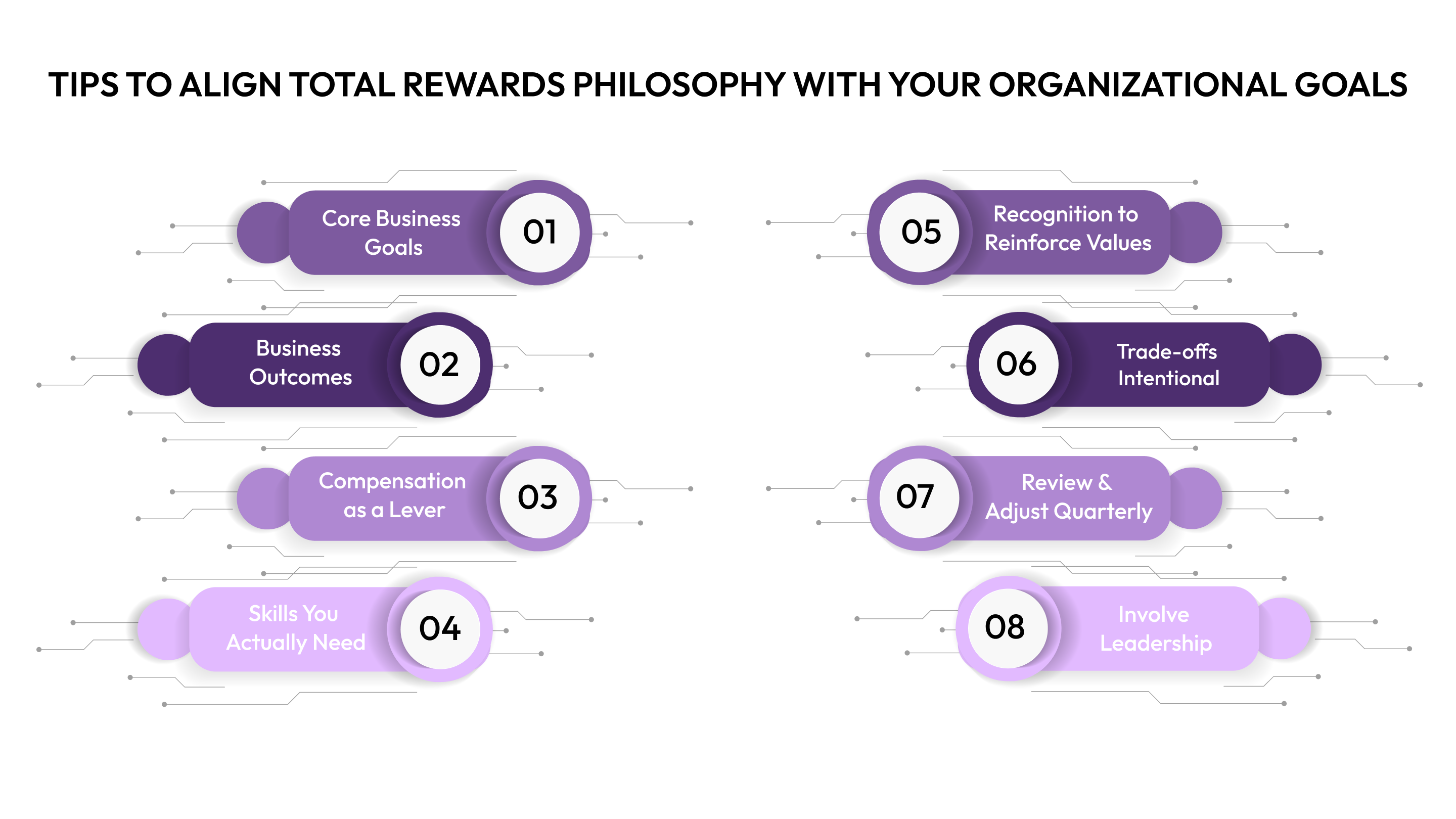
A total rewards program works best when it directly supports your company's goals. Random perks feel nice, but don't drive results. Strategic alignment does.
Here's how to ensure your program serves both employees and your business:
Tip 1: Start With Your Company's Core Business Goals
What are you trying to achieve this year? Rapid growth? Market expansion? Product innovation? Cost efficiency? Revenue targets?
Your total rewards program should reinforce these goals, not distract from them.
Tip 2: Map Employee Behaviors to Business Outcomes
Ask yourself: What behaviors do we need employees to exhibit to hit our goals?
If your goal is innovation, reward experimentation and calculated risk-taking. If it's customer retention, reward longevity and deep client relationships. If it's growth, reward sales performance and new business development.
Misaligned rewards create friction. Aligned rewards amplify momentum.
Tip 3: Use Compensation as a Lever
Tie bonuses and incentives directly to the outcomes you care about. Make the connection clear so employees understand how their effort directly impacts their earnings.
Tip 4: Design Development Programs for Skills You Actually Need
Don't offer training just because it sounds good. Invest in skill development that moves your business forward.
If you need more skilled engineers, fund coding bootcamps and certifications. If you need better leaders, sponsor leadership development. Make training strategic, not generic.
Tip 5: Use Culture and Recognition to Reinforce Values
Your culture should scream what you stand for. If you value collaboration but only recognize individual stars, you're sending mixed signals.
Use recognition programs to celebrate behaviors aligned with your values:
- Value speed? Recognize fast decision-makers
- Value customers? Celebrate customer-centric wins
- Value innovation? Highlight bold ideas and experiments
- Value diversity? Highlight inclusive leadership
Tip 6: Make Trade-offs Intentional
You can't optimize for everything. If you're a lean startup, you might offer lower base pay but higher equity upside. If you're an established company, you can offer stability and comprehensive benefits.
Own your trade-offs. Communicate them clearly. Employees respect honesty more than false abundance.
Tip 7: Review and Adjust Quarterly
Your business goals shift. Your market changes. Your competition moves. Your total rewards program should evolve with these shifts.
Schedule quarterly reviews to assess whether your program still supports your current priorities. Double down on what's working. Pivot what isn't.
Tip 8: Involve Leadership in the Conversation
Executives must understand how total rewards connect to strategy, not just view it as an HR expense. When leadership buys in, they model the behavior and champion the program authentically.
When your total rewards strategy is tightly woven into your business goals, Employees see the connection between their work and company success. They become partners in achieving your vision, not just workers collecting paychecks.
Creating a culture where employees feel genuinely cared for is foundational. When employees see that their well-being matters, not just their output, everything shifts. Learn more about how total rewards support employee well-being and why it's increasingly critical to organizational success.

Bringing It All Together
Total rewards philosophy isn't just a concept; it's a strategy for organizational growth. The challenge lies in translating vision into action, especially with compensation cycles and employee data.
CandorIQ empowers HR leaders and finance teams to design, implement, and optimize total rewards programs with data-driven insights and AI-assisted recommendations. From creating transparent compensation structures to speeding up merit cycles, CandorIQ simplifies the process.
Ready to transform your total rewards strategy? Book a demo with CandorIQ to streamline your compensation planning and boost employee satisfaction and retention.
Frequently Asked Questions
1. What's the difference between total rewards and compensation?
Compensation is just salary and bonuses. Total rewards encompass everything: compensation, benefits, career development, culture, flexibility, and recognition. Total rewards are holistic; compensation is one component.
2. How do I measure if my total rewards program is working?
Track metrics like employee retention rate, engagement scores, internal promotion rates, benefits utilization, and eNPS. Compare year-over-year to see trends. Also, collect qualitative feedback through surveys and stay interviews.
3. Should we offer the same rewards to all employees?
No. Different employee personas want different things. A 25-year-old early-career professional may prioritize training and growth, while a parent might prioritize flexible hours and health benefits. Offer choices where possible.
4. How often should we update our total rewards program?
Review quarterly to ensure alignment with business goals. Major redesigns can happen annually or every 18 months, but the program should evolve as your business changes.
5. How do we communicate the total rewards value to employees?
Create an annual Total Compensation Statement showing base salary, benefits value, PTO days, bonuses, and other perks translated into dollar value. Many employees don't realize what they're actually receiving.


